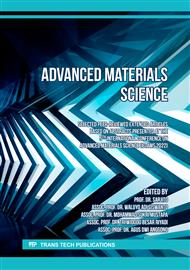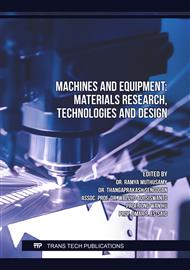[1]
D. Maryanto;, S. A. Mulasari;, and D. Suryani., Reducing Carbon Monoxide (CO) Exhaust Emission Levels With The Addition Of Activated Charcoal In Motor Vehicles In Jogjakarta,, KesMas, vol. 3, no. 3, p.162–232, (2019).
Google Scholar
[2]
Ismiyati, D. Marlita, and D. Saidah, Air Pollution Due to Motor Vehicle Exhaust Emissions,, J. Manaj. Transp. and Logistik, vol. 1, no. 3, p.241–248, (2014).
DOI: 10.54324/j.mtl.v1i3.23
Google Scholar
[3]
H. A. Delvi;, M. F. A. Khan;, K. K. M;, and M. Kareemullah, Effect of Ethanol-Gasoline Blends on Performance, Combustion And Emmision Characteristics Of Spark Ignition Engine,, J. Adv. Res. Fluid Mech. Therm. Sci., vol. 62, no. 2, p.209–220, (2019).
Google Scholar
[4]
Lelawati, Motorcycle Exhaust Emission Testing With Premium Fuel,, Teknis Simes Magazine, vol. 11, no. 1, p.1–5, (2017).
Google Scholar
[5]
A. Supriyanto;, H. Maksum;, and D. S. Putra, Comparison of the Use of Various Types of Fuels on Exhaust Emissions in 4 Stroke Motorcycles,, AEEJ, (2018).
Google Scholar
[6]
A. H. Listiyono, Bambang Irawan, Optimization of the Composite Absorber on the Muffler to Reduce Gasoline Motor Exhaust Emissions,, J. Energi and Teknol. Manufaktur, vol. 02, no. 01, p.13–22, (2019).
DOI: 10.33795/jetm.v2i01.33
Google Scholar
[7]
A. S. Nugroho;, Y. Y. Kristiawan;, and Thoharudin., Reduction of CO and HC Emission on ZSM-5 Catalyst Supported on Activated Carbon in Motorcycle Fueled Gasoline-Ethanol Blends - 1196-1200.pdf,, J. Eng. Appl. Sci., vol. 11, no. 6, (2016).
Google Scholar
[8]
A. Pujiono, A. Feriansah, N. E. Matantu, and C. Converter, The effect of the use of a copper catalytic converter on vehicle exhaust emissions on a 2-stroke yamaha f1zr . motorcycle,, vol. 6, (2019).
Google Scholar
[9]
S. Dey; and G. C. Dhal, Controlling carbon monoxide emissions from automobile vehicle Exhaust using Copper Oxide cataysts In A catalytic Converter,, Matrial Today Chem., vol. 17, (2020).
DOI: 10.1016/j.mtchem.2020.100282
Google Scholar
[10]
R. B. Irawan;, Purwanto;, and Hadiyanto., Demonstrating the Ability of the Model 4 Manganese-Coated Copper Catalyst in Reducing Carbon Monoxide Gas Emissions in Gasoline Motors,, TRAKSI, vol. 15, no. 2, p.27–44, (2015).
DOI: 10.1016/j.proenv.2015.01.013
Google Scholar
[11]
D. R. S. D. Widjanarko, The Use of TiO2 Powder and Activated Carbon As A Mixture Of Ceramic Catalytic Converter To Reduce Harmful Pollutants in Motorized Vehicles,, J. Rekaya Kim. dan Lingkung., vol. 13, no. 2, p.165–173, (2018).
DOI: 10.23955/rkl.v13i2.11901
Google Scholar
[12]
M. Siregar;, C. Siregar;, Muharnif;, A. Siregar;, and I. Maulana, Application of catalytic converter copper catalyst with honeycomb surface to reduce emisions of flue gas in motorcycle,, (2019).
DOI: 10.1088/1757-899x/674/1/012060
Google Scholar
[13]
M. Zaharin, N. Abdullah;, M. I. Dahalan;, and H. Shrudin, Experimental Study On The Effects of Methanol and Ethanol on GasolineEngine Performance And Exhaust Emissions,, J. Mech. Eng., vol. 2, no. 2, p.27–44, (2017).
Google Scholar
[14]
H. Ozcan;, M. Ozbey;, and O. Gursel, The Effect Of Ethanol-Gasoline, Methanol-Gasoline And Ethanol-Methanol-Gasoline Blends On Engine Performance, Combustion Characteristics, And Exhaust Emissions,, Int. J. Eng. Sci. ( IJES), vol. 7, no. 6, p.70–82, (2018).
DOI: 10.1016/j.energy.2018.05.120
Google Scholar
[15]
A. Elfasakhany, Investigations on the effects of ethanolemethanolegasoline blends in A Spark Ignition Engine Performance And Emiision Analysis,, Eng. Sci. Technol. An Int. J., vol. 30, p.1–7, (2015).
Google Scholar
[16]
Sukardi;, M. A. Pribadi, and A. Sampurno., Effect of Engine Tuning Using Gasohol E15 Gasoline on Emissions,, J. Energi Dan Teknol. Manufaktur ( JETM), vol. 2, no. 1, p.1–6, (2019).
DOI: 10.33795/jetm.v2i01.29
Google Scholar
[17]
Yuliusman;, J. Sinto;, Y. Nugroho;, H. I. Nafan;, A. R. Nafisah;, and S. Sipangkar, Motor vehicle exhaust carbon monoxide and hydrocarbon emission Content Reduction By Banana Peel Activated carbon.pdf,, (2020).
DOI: 10.1088/1742-6596/1430/1/012003
Google Scholar
[18]
I. M. M. I. M. . Sayogo I.M. Nuarsa I.B. Alit, Analysis of Exhaust Emissions of Ethanol-Fueled Vehicles,, Din. Tek. Mesin, vol. 9, no. 1, p.45–57, (2019).
Google Scholar
[19]
P. Iodice;, G. Langella;, and A. Amoresano, Ethanol Gasolin Fuel Blend Effect on Fuel Consumption And Engine Emmisions Of SI Engines In Cold Operating Conditions- 2017.pdf,, Appl. Therm. Eng., (2017).
DOI: 10.1016/j.applthermaleng.2017.11.090
Google Scholar
[20]
R. C. Putra and A. Rosyidin, The effect of octane value on the performance of gasoline motors and fuel consumption using standard-racing spark plugs,, vol. 18, (2020).
Google Scholar
[21]
S. Yelbey; and M. Ciniviz, Investigation Of The Effect Of Gasoline-Bioethanol Blends On Engine Performance And Exhaust Emissions In A Spark Ignition Engine,, Eur. Mech. Sci., vol. 4, no. 2, p.65–71, (2020).
DOI: 10.26701/ems.635790
Google Scholar



